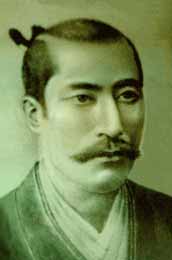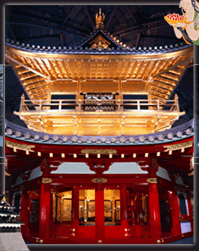

(1534–82). The prime mover of Japan's 16th-century reunification after a hundred years of strife. The Sengoku period (1467–1568) ended and the Azuchi-Momoyama period (1568–1600) began with his advent to power.
Rising from modest beginnings, Nobunaga subjected central Japan to one governing authority, with himself as the supreme hegemon. At the time of his violent death the realm (tenka) united under his rule comprised over a third of the 16th-century Japanese empire. The rigorous system of government he left behind—later called the Shokuho seiken (Shokuho regime)—was the foundation for the work of the other two of the “Three Heroes” of Japan's unification, his sometime vassals Toyotomi Hideyoshi and Tokugawa Ieyasu. Nobunaga, who dealt ruthlessly with his enemies, deserves his reputation as a brutal warlord, but he was also an enthusiastic patron of the arts and a powerful stimulus for the brilliant culture of the Azuchi-Momoyama period.
Provenance and Early Career—Nobunaga's family was a sublineage of a shugodai (deputy military governor) house settled in Owari Province (now part of Aichi Prefecture) since about 1400. His father, Nobuhide (1510–51), nominally a vassal of the Kiyosu branch of the Oda, who were shugodai of Owari's “lower four districts,” was actually a Sengoku daimyo in his own right. After his father's death in 1551 Nobunaga, his heir, first consolidated his position as the lord of Nagoya Castle and then began his campaign of military expansion. In 1555 Nobunaga seized Kiyosu, killed the shugodai, Oda Hikogoro, and moved from Nagoya into the castle there. After a protracted campaign, he succeeded in 1559 in reducing the fortress of Iwakura, the seat of the shugodai of Owari's “upper four districts,” gaining control of all of Owari. In 1560 Nobunaga's position was challenged by Imagawa Yoshimoto of Mikawa Province (now part of Aichi Prefecture). Nobunaga surprised and routed Imagawa's vastly superior army at the Battle of Okehazama (now the city of Toyoake, Aichi Prefecture) the same year. By 1562 he had entered into an alliance with Imagawa's Mikawa vassal Matsudaira Motoyasu (the future shogun Tokugawa Ieyasu), thus securing his eastern flank.
In 1567, after repeated invasions of Mino, the domain of Saito Tatsuoki (1548–73), Nobunaga seized Saito's Inokuchi Castle. He renamed the castle Gifu and declared its marketplace, Kano, a duty-free market (see rakuichi and rakuza). By the spring of 1568 Nobunaga had subdued much of northern Ise Province (now part of Mie Prefecture).
In the fall of 1568 Nobunaga marched on Kyoto, swept aside armed opposition from Rokkaku Yoshikata (1521–98) and his son Yoshiharu (1545–1612) of Omi Province (now Shiga Prefecture) and from the Miyoshi Triumvirs (Miyoshi Sanninshu), and installed Ashikaga Yoshiaki as shogun. However, he forced the new shogun to acknowledge Nobunaga's primacy in the realm's affairs. Nobunaga's successes continued unimpeded through 1569, when he gained control over the merchant city and firearms manufacturing center of Sakai and expanded into southern Ise. In Ise Nobunaga decreed the abolition of toll barriers (sekisho) restricting the free flow of commerce and ordered the destruction of the rural gentry's forts.
By 1570 Nobunaga's steady advance brought into being a coalition of daimyo intent on stopping him. Nobunaga tossed down the gauntlet to them in the late spring of 1570 by invading Echizen (now part of Fukui Prefecture), the domain of Asakura Yoshikage. Nobunaga had to retreat when Asai Nagamasa, the daimyo of Odani in northern Omi, attacked his rear; he barely managed to return to Gifu when the remnants of Rokkaku Yoshikata's party rose again in southern Omi, cutting Nobunaga's communications with his home base. That summer Nobunaga and Tokugawa Ieyasu defeated Asai's and Asakura's forces at the Battle of Anegawa, but it was not a decisive victory: within 10 weeks Asai and Asakura had recuperated enough to advance into the vicinity of Kyoto. They entered into an alliance with Kennyo Kosa (1543–92), the pontiff of Honganji in Osaka. Nobunaga neutralized Asai's and Asakura's threat to Kyoto, scattering their troops on Mt. Hiei (Hieizan), where their collaborators in Enryakuji, the headquarters of the Buddhist Tendai sect, gave them shelter. The next year Nobunaga burned Enryakuji in retaliation (see Enryakuji, burning of).
Honganji, head temple of the major branch of the Jodo Shin sect, proved a far more formidable opponent. Kennyo and the armed leagues (Ikko ikki) of his sectarians (monto) fought Nobunaga in a war that lasted with a few interruptions from 1570 to 1580. The year 1570 ended with a massive rising of the Ikko ikki of Nagashima in Ise. Nobunaga was to invade Nagashima unsuccessfully twice before he finally managed to subdue this Ikko ikki in 1574 through wholesale slaughter.
By 1572 Nobunaga and the coalition ranged against him were stalemated. Nobunaga's enemies sought to break the deadlock by persuading the powerful eastern daimyo Takeda Shingen to join their league. On 6 January 1573 Shingen defeated Tokugawa Ieyasu's and Nobunaga's allied army at the Battle of Mikatagahara in Totomi (now the city of Hamamatsu, Shizuoka Prefecture). Two months later he took Noda Castle in Mikawa (now the city of Shinshiro, Aichi Prefecture), penetrating deeply into Ieyasu's territory. The news of Shingen's successes enticed the shogun, Yoshiaki, to take up arms against Nobunaga, who assumed a conciliatory attitude until news of Shingen's death reached him. At the beginning of May 1573 Nobunaga surrounded Kyoto and methodically put its periphery to the torch, forcing Yoshiaki into surrender. When the shogun rose again in July, Nobunaga chased him into exile. De jure, the Muromachi shogunate (1338–1573) continued to exist until Yoshiaki's abdication in 1588; de facto, Nobunaga's hegemony had replaced it.
In September 1573 Nobunaga attacked Asai Nagamasa; when Asakura Yoshikage came to his ally's relief, Nobunaga defeated him and forced him to commit suicide. Having thereby conquered Echizen, Nobunaga eliminated Asai and assigned his domains in northern Omi to Hashiba Hideyoshi (the future Toyotomi Hideyoshi). Nobunaga's triumph was tarnished, however, by a rebellion that swept Echizen in early 1574. Honganji reopened hostilities on the Osaka front, and the Takeda, led by Shingen's son Takeda Katsuyori, again invaded Ieyasu's territories. Nobunaga recovered this lost ground in 1575 by a spectacular victory over Takeda Katsuyori at the Battle of Nagashino in Mikawa (now Horai Cho, Aichi Prefecture) and by another gruesome slaughter of the Honganji's sectarians, this time in Echizen.
Nobunaga now dominated Kyoto and the five provinces of the Kinki area around it; he held Owari, Mino, Ise, Omi, Wakasa (now part of Fukui Prefecture), and Echizen; his “tenka” (realm) included Mikawa and Totomi, the domains of Tokugawa Ieyasu, who acknowledged Nobunaga's primacy. By 1577 Shibata Katsuie, Nobunaga's appointee to the governorship of Echizen, had implemented there the policies that became the identifying features of the Shokuho regime: the sword hunt (katanagari; confiscation of weapons from the populace), the separation of the agricultural and military classes (heino bunri), and the provincial land survey (kenchi).
Climax and Abrupt End of Career—In 1576 Nobunaga began building a residential castle at Azuchi in Omi Province (now Azuchi Cho, Shiga Prefecture). Azuchi Castle, whose central donjon (tenshu) became Nobunaga's official residence in 1579, contributed its name to the Azuchi-Momoyama period, which is fittingly called an age of grandeur.
In 1576 a second coalition formed against Nobunaga: the diplomatic efforts of the exiled shogun Yoshiaki and Kennyo Kosa of Honganji incited Mori Terumoto (1553–1625), the lord of Aki Province (now part of Hiroshima Prefecture) and vast other territories in the Chugoku region, and Uesugi Kenshin (1530–78), the daimyo of Echigo (now part of Niigata Prefecture), into joining the effort to stop Nobunaga. A fleet sent by Mori broke through Nobunaga's blockade of Ishiyama Honganji, Kennyo's temple fortress in Osaka. On the southwest of his “realm,” Nobunaga campaigned in the spring of 1577 against the Ikko ikki of Saiga in Kii Province (now the city of Wakayama). On the south, Matsunaga Hisahide (1510–77) of Yamato (now Nara Prefecture) took up arms against Nobunaga but was destroyed, his province conquered by Nobunaga's eldest son Nobutada (1557–82) and his generals Akechi Mitsuhide, Hosokawa Yusai, and Tsutsui Junkei. The colossal struggle with the Mori of the northwest and the west of the “Tenka” was to be the major military effort of Nobunaga's last years, but remained unfinished at his death.
The situation eased for Nobunaga in 1578 with the sudden death of his formidable enemy Kenshin, which was followed by a succession struggle in the Uesugi family. Nobunaga and his generals, including Hideyoshi, gradually reduced the defenses of the Mori by early 1580. Honganji itself was isolated, and Kennyo Kosa entered into peace negotiations. The surrender of the Osaka Honganji in 1580 was Nobunaga's greatest victory. The victory was completed late that year with the conquest of the part of Kaga that was still held by monto, and the religious monarchy of the Jodo Shin sect accordingly ceased to exist. One of the greatest symbols of the Japanese middle ages had fallen.
In the spring of 1582, Nobunaga celebrated another great triumph: the destruction of Takeda Katsuyori and the incorporation of four more provinces—Suruga (now part of Shizuoka Prefecture), Kai (now Yamanashi Prefecture), Shinano (now Nagano Prefecture), and Kozuke (now Gumma Prefecture)—into his realm. The imperial court then offered to make him shogun or “appoint him to any rank at all,” but Nobunaga evaded replying to this offer.
In June 1582 an army commanded by Nobunaga's son Kambe Nobutaka (1558–83) assembled in the area of Osaka and Sakai and stood poised to invade Shikoku. Another large force was encircling Kongobuji, the great monastery of the Buddhist Shingon sect on Mt. Koya (Koyasan) in Kii Province. On the San'indo front in western Honshu, Mori Terumoto's major fortress, Tottori, had fallen to Hideyoshi in 1581; Hideyoshi had turned to the San'yodo front and was besieging Takamatsu in Bitchu Province (now part of the city of Okayama), the fort of Mori's vassal Shimizu Muneharu. At the news that Mori's main force had come to the relief of Takamatsu, Nobunaga himself planned to join the campaign. He ordered Akechi Mitsuhide to lead a force in the expedition's van.
On 19 June Nobunaga arrived in Kyoto on his way to the front and took up his habitual quarters at Honnoji, a temple of the Buddhist Nichiren sect. In the early morning of 21 June 1582 Akechi attacked Honnoji, catching Nobunaga completely by surprise. According to the chronicle Shincho Ko ki, Nobunaga realized that all was lost but defended himself until he was wounded. He then made sure that all women abandoned the temple, which was in flames, withdrew into the depths of the building, locked himself in a service room to keep the enemy from witnessing his end, and there disemboweled himself. See also Honnoji Incident.

| SEO | [PR] 爆速!無料ブログ 無料ホームページ開設 無料ライブ放送 | ||
